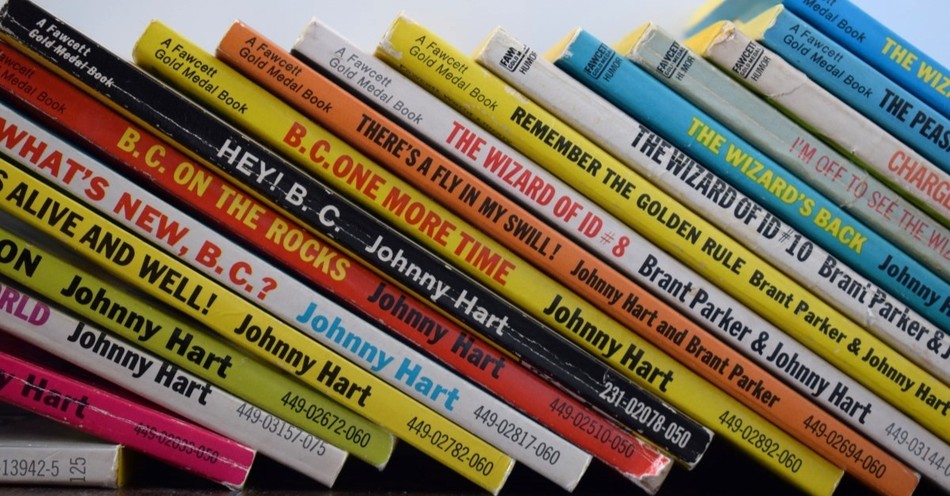Fans of the comic strips The Wizard of Id and B.C. know that Johnny Hart was a great cartoonist. They may not know that Chuck Colson once described Hart as “the most widely read Christian of our time.” According to the Los Angeles Times, when Hart died in 2001, his comics reached over 100 million daily readers. He was also one of only four cartoonists with two comic strips appearing in over 1,000 newspapers.
Particularly in the last 15 years of his career, Hart worked his beliefs into dozens of comic strips—sometimes gaining praise, sometimes criticism.
10 Important Events in Johnny Hart’s Life
1. John Lewis Hart was born on February 18, 1931, in Endicott, New York.
2. In 1950, Hart submitted art to a high school contest. Brant Parker, a staff artist with the Binghamton Press, judged the contest and met with Hart over lunch to discuss his work. Years later, in 1964, they would work together on The Wizard of Id.
3. Hart joined the United States Air Force in 1950. His years in the Air Force had many changes. In 1951, while stationed in Warner Robins, Georgia, he met Ida Jane “Bobby” Hatcher. They married in 1952 and went on to have two daughters. In 1953, while stationed in Korea, Hart began his professional cartooning career, with several comics published in Pacific Stars and Stripes.
4. In 1954, Hart started his freelance cartooning career with a piece published in the Saturday Evening Post. By this stage, he was discharged from the Air Force and living with Bobby’s family in Georgia.
5. In 1956, Hart was working in General Electric’s art department—coworkers inspired many of his future characters. That year, he discovered Charles Schultz’s Peanuts and felt inspired to create his own comic strip.
6. In 1958, Hart submitted his caveman comic strip to the New York Herald Tribune. He later recalled that the editor in charge of acquiring comics, Harry Welker, took a chance because Welker had turned down Peanuts in 1954. Ten years later, Hart and Parker sold The Wizard of Id.
7. In 1965, Hart’s mother, Grace, died of cancer. He would later admit this led to several bitter “back-sliding years,” where he struggled with alcoholism and felt personally unfulfilled despite his professional success.
8. In 1976, Hart bought a surprise birthday present for Bobby: a new home in the small town of Nineveh, New York. He later joked that everyone who runs away from God ends up in Nineveh eventually and felt God was working through the move.
9. In 1984, Hart installed a satellite dish at his art studio. The father-son team installing the dish were Christians who used a religious station to test the dish. Hart overheard the sermons on the T.V. while he worked and became interested in Christianity. Afterward, he and Bobby joined Nineveh Presbyterian Church.
10. On April 7, 2007, Hart passed away while working in his studio. Parker passed away eight days later. Hart’s grandsons, Mason and Mick Mastroianni, continue to produce B.C. and The Wizard of Id today.
Quotes by or about Johnny Hart
Unless otherwise noted, quotes are taken from the book Growinggold with B.C.
1. “I often think that God certainly routed me in this direction and seated me at a drawing board. There were times when I could make choices of what I wanted to do, but there was always the one thing, the only thing, at that particular time that I could do or knew how to do—draw cartoons.” — interview in Hogan’s Alley
2. “… always the clown, the silly one, the child in us we all tried to hide after we became adults with responsibilities and pseudo self-importance.” — Jack Caprio
3. “Cavemen, for reasons I can’t explain, were an obsession in those days… but I never could sell one to a magazine. One night, I was leaving the art department at General Electric, and I’m telling the guys, ‘I’m going home to create a nationally famous comic strip tonight.’ As I’m leaving, one of the guys says, ‘Why don’t you do one about cavemen? You can’t sell them anywhere else!’” — Johnny Hart
4. “Brant probably makes me feel better than any other human being that I’m ever with because... I just can’t explain it. He brings the wacky side of me out. When I’m with him I’m like a stand-up comic. Like a Don Rickles. Laying out one-liners and he just laughs and laughs.” — interview in Hogan’s Alley
5. “Johnny is the most controversial person on the comics pages… Johnny is also the most courageous person on the comics pages. To be outspoken on the subject of Christianity is exposing yourself to ridicule. It’s easy to mock the religious believer.” — Richard S. Newcombe, quoted in the Washington Post
6. “… there is a purpose here. I do think that. I’m not very good at picking up on where God is leading me. But the purpose is the hot dog on the end of the stick. It’s there.” — interview with Hogan’s Alley
7. “‘Being hurtful is not part of my nature,’ [Hart] says. For years, B.C. has featured the Truth Pedestal, onto which people climb and make fools of themselves. ‘You know the saying, God wrote the Ten Commandments, not the Ten Suggestions?’ Hart asks. ‘You could reverse it. I don’t want to be thought of as standing on the Truth Pedestal shouting commandments.” He considers. ‘I’d rather be thought of as shouting...suggestions.’” — Time article by David Van Biema
8. “Prayer is allowing God to have his will in your life on HIS terms.” — Johnny Hart (quoted in I Did It His Way)
9. “When John began doing religious strips we knew there would be controversy. All he really wanted was for his readers to enjoy his work, look up Scriptures, maybe get a few laughs, and tell others about the message he prayed they would receive. Hart never wrote a strip with the intention of offending anyone. That simply wasn’t his nature.” — Bobby Hart
10. “By subtly introducing “his values” into his comic strips, Hart is proving the wisdom of C. S. Lewis, who once observed that believers would be much more effective in getting their message out if they did not always try to evangelize by hitting people over the head with scripture.” — Chuck Colson, Breakpoint
10 Lessons from Johnny Hart
1. The artist never works alone. Musician Matthew Clark has observed that good art only happens in collaboration, and Hart’s work showed that. Several friends and family members contributed jokes for his work—notably his childhood friend, Jack Caprio, who also served as his business manager and the inspiration for the character Clumsy Carp.
2. Setting goals helps artists finish projects. In her foreword to Growingold with B.C., Bobby Hart recalls early frustrating days when Hart declared, “Before I am 27 years old, I will have a syndicated strip.” The first B.C. comic strip appeared the day before Hart celebrated his 27th birthday.
3. Artists can take inspiration from real life. Hart freely admitted that many of his characters were based on people he knew—General Electric colleagues, family members, and friends. Ironically, his least well-developed characters (the female cave dwellers) are not based on other people.
4. The key to success is persistence. Hart observed in his introduction to Growinggold with B.C. that he nearly gave up on B.C. after it had been rejected five times. Instead, he decided to contact the New York Herald Tribune in person, which led to the work getting accepted.
5. Poking fun is fine if the comedian is humble. Given how many of Hart’s characters were based on people he knew, the foibles and mistakes those characters made could have become offensive. However, he was just as willing to poke fun at himself. B.C., the main character in that comic, was based on himself and often got into the most trouble.
6. Art about faith may offend. After his 1984 conversion, Hart increasingly worked references to Christianity into his comics—such as a comic featuring a cross with a note saying, “To Be Continued.” Sometimes people took offense at these religious references, although religious and non-religious cartoonists (including Gary Trudeau) defended his right to include his views in his work.
7. Religious comedy can be irreverent. While Hart never criticized Christianity in his comics, he wasn’t above making gentle jokes about the Bible. For example, I Did It His Way reprints a poem about Absalom, whose “bouffant hair” got him in trouble.
8. Every artist has something that influenced them. Hart’s style differed from Peanuts, but he always admitted how much Schultz’s work inspired him to start his career. He later contributed a foreword to the Peanuts Treasury, discussing how much Schultz’s comedy still inspired him.
9. The best comedy comes from a kind place. Hart admitted he had a snarky tone to his humor but wasn’t afraid to apologize when his humor was misconstrued. When an Easter cartoon featuring a cross and a menorah upset Jewish readers, he responded, “This is a holy week for both Christians and Jews, and my intent was to pay tribute to both… I sincerely apologize if I have offended any readers, and I also sincerely hope that this cartoon will generate increased interest in religious awareness.”
10. Giving back to the community matters. While Hart traveled and received international acclaim, he spent most of his life in New York’s Broome County. He would use his celebrity to give back to that community in various ways—giving artwork for local events and supporting Endicott’s PGTA Tour, the B.C. Open.
10 Great Books by Johnny Hart
Unless otherwise noted, these books are written by Hart.
1. Johnny Hart’s B.C.: A Special Christmas
2. My Vat Runneth Over!: A Wizard of Id Collection by Brant Parker and Johnny Hart
3. Growingold with B.C.: A Celebration of Johnny Hart
4. Growingold with B.C.: A Continued Celebration of Johnny Hart
5. I Did It His Way: A Collection of B.C. Religious Comic Strips
6. The Best of The Wizard of Id by Brant Parker and Johnny Hart
7. The Best of B.C.: 58 Years of Pithy Prehistoric Puns and Fun
8. The Art and Humor of Johnny Hart edited by R.C. Harvey, Eileen Sabrina Herman, and Daniel Herman
9. Basic Christianity: Facts, Evidences, Reasons by Stanley D. Walter. Walter’s book includes a selection of Hart’s comics about religion as illustrations for his discussions about faith.
10. The Remnant: A Prophetic Fable by Linda Bowles and illustrated by Johnny Hart. While not written by Hart, this 1999 satire about God appearing in a post-Christian America in 2046 makes some interesting points that continue to be topical.
More can be learned about his work at John Hart Studios.
To read more Christianity.com articles about humorists or a Christian view of comedy, read:
10 Things You Need to Know about G.K. Chesterton
100 Christian Novels You Haven’t Read Yet
Why Should We Remember Malcolm Muggeridge?
Does God Have a Sense of Humor?

This article is part of our People of Christianity catalog that features the stories, meaning, and significance of well-known people from the Bible and history. Here are some of the most popular articles for knowing important figures in Christianity:
How Did the Apostle Paul Die?
Who are the Nicolaitans in Revelation?
Who Was Deborah in the Bible?
Who Was Moses in the Bible?
King Solomon's Story in the Bible
Who Was Lot's Wife in the Bible?
Who Was Jezebel in the Bible?
Who Was the Prodigal Son?




.jpg)